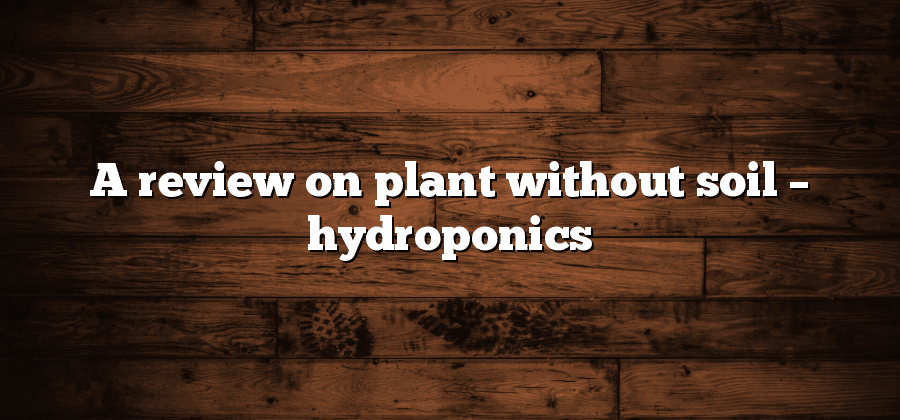History and Origins of Hydroponics
Hydroponics, a revolutionary method of plant cultivation, has a rich and intriguing history that dates back thousands of years. The ancient civilizations of Babylon, Egypt, and China were some of the earliest practitioners of hydroponics, showcasing their ingenuity and understanding of plant nutrition. By suspending plants in water and providing them with essential nutrients, these early pioneers were able to successfully grow crops in environments where traditional soil cultivation was impossible.
Despite its ancient origins, hydroponics did not gain widespread recognition until the 20th century. The development of modern hydroponics can be attributed to the experiments conducted by scientists and researchers such as William Frederick Gericke in the 1920s. Gericke’s work laid the foundation for commercial hydroponic systems, leading to its adoption in horticulture, scientific research, and even space exploration. Today, hydroponics continues to evolve and gain popularity as an innovative and sustainable method of plant cultivation.
Advantages of Soilless Plant Cultivation
Soilless plant cultivation, also known as hydroponics, offers numerous advantages over traditional soil-based methods. One of the key benefits is the enhanced control over nutrient levels, allowing growers to precisely provide the essential elements plants need for optimal growth. With hydroponics, there is no reliance on the natural composition of soil, which can vary greatly in terms of nutrient content. Growers can create a tailored nutrient solution, ensuring plants receive the exact balance of minerals they require for healthy development. This level of precision leads to faster growth rates, higher yields, and better overall plant health.
Another advantage of soilless plant cultivation is the efficient use of resources. Unlike traditional farming, hydroponics uses significantly less water, often up to 90% less. This is because water in a hydroponic system is recirculated, preventing wastage. Additionally, the controlled environment of hydroponics allows for better water management, reducing the risk of over or under watering. The efficient use of water is not only beneficial for the environment but also for the grower’s bottom line, as it lowers water bills and conserves a precious resource. Moreover, hydroponic systems require less space compared to traditional farming methods, making it ideal for urban areas or locations with limited land availability. This allows for year-round cultivation in areas where traditional agriculture may not be feasible.
Understanding Different Hydroponic Systems
Hydroponics, the method of growing plants without soil, offers a versatile approach to cultivation that can be adapted to different needs and environments. There are several different types of hydroponic systems to choose from, each with its own unique advantages and considerations. One popular system is the nutrient film technique (NFT), where a thin film of nutrient-rich water continuously flows over the roots of the plants. This allows for efficient nutrient uptake and oxygenation while minimizing the use of water and space. NFT systems are particularly well-suited for smaller plants with shallow root systems, such as lettuce and herbs.
Another commonly used system is the ebb and flow, or flood and drain, system. In this method, the plants are periodically flooded with nutrient solution before the excess water drains away. The ebb and flow system promotes oxygenation of the roots and encourages vigorous growth. It is a versatile system that can be adapted to suit plants of different sizes, making it a popular choice among hydroponic growers. The ebb and flow system is often utilized for larger plants such as tomatoes and peppers, as well as flowering plants like roses and orchids.
Nutrient Solutions: The Key to Plant Growth
Nutrient solutions play a crucial role in the growth and development of plants in hydroponic systems. In traditional soil-based cultivation, plants extract the necessary nutrients from the surrounding soil. However, in hydroponics, where plants are grown without soil, it is essential to provide them with a balanced and tailored nutrient solution.
These solutions are carefully formulated to contain all the essential elements that plants need to thrive, including macronutrients such as nitrogen, phosphorus, and potassium, as well as micronutrients like iron, calcium, and magnesium. By supplying the plants with a precise blend of these nutrients, hydroponic growers can optimize plant growth and maximize yields. Nutrient solutions can be adjusted depending on the specific needs of different plant varieties, allowing for greater control over plant nutrition and growth. The ability to fine-tune nutrient solutions is one of the significant advantages of hydroponic systems, as it enables growers to address deficiencies or excesses promptly, promoting healthier and more productive plants.
Essential Equipment for a Successful Hydroponic Setup
Hydroponics, the art of growing plants without soil, requires a specific set of equipment to ensure successful plant cultivation. From basic essentials to more advanced tools, investing in the right equipment is crucial for a thriving hydroponic setup. Let’s delve into some of the essential equipment needed for a successful hydroponic system.
The first and most fundamental piece of equipment for hydroponic gardening is a growing medium. Unlike traditional soil-based gardening, hydroponics relies on inert materials such as perlite, coco coir, or rockwool to support plant root systems. These growing mediums provide stability, aeration, and moisture retention, allowing plants to flourish. Choosing the appropriate growing medium depends on factors such as plant type, growing system, and personal preference. Alongside a suitable growing medium, a quality pH meter is indispensable for monitoring and adjusting the nutrient solution’s acidity level. Maintaining the correct pH range helps plants absorb nutrients efficiently, promoting healthy growth and minimizing nutrient deficiencies. Accurate pH readings are essential for troubleshooting any issues that may arise during the hydroponic growing process.






